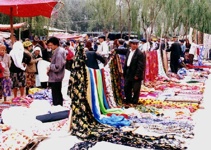The evening light dances on the glazed pink tiles of the shapely buildings around the ancient Idkah mosque and in the enfolding dusk the site evokes tales from the ‘One thousand and one nights’. But the illusion is fleeting — none of the buildings in this spot, except for the revered mosque, is more than a few years old.
In broad daylight the exotic shapes of the building are revealed as ersatz creations furnished with minarets. The intimacy of old jam-packed curio shops has been replaced with the uniformity of cavernous but still empty shopping malls.
The once teeming bazaar lanes and overloaded stalls in front of the Idkah in this city on the fringes of China’s western Xinjiang province have been cleared away to make space for a large empty square.
“The new city centre is more beautiful than the old one,” insists Askaer, a local communist party official, who comes from the Muslim Uygur minority in western China and uses only one name. These new buildings may not be original but they make the city look modern and attractive to tourists, he says, effectively parrying questions about the value of authenticity.
For centuries the Chinese had fought for control of this city with its riches of silks, spices and other luxuries. They sought to rule over these remote western lands inhabited by independent-minded Uygurs for they were a vital corridor of land connecting China with central and southern Asia and distant Europe. This famed stop on teh ancient Silk Road once had bustling bazaars where more than ten languages could be heard.
Now it seems Beijing is closer than ever to achieving its goal of stamping its seal of authority on the place. It is rebuilding the old Kashgar with an eye on attracting tourism, but with its ubiquitous central square and gaudy new buildings the city resembles many other modernised Chinese cities. [Full Text]








